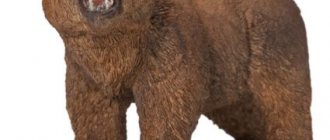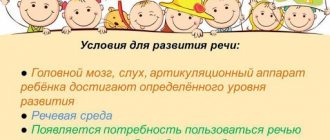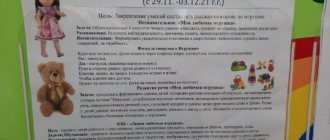Preview:
Self-analysis of an open lesson with non-traditional
drawing techniques “Autumn trees”
Direct educational activities were carried out with children of senior preschool age with a subgroup of 10 children.
GCD theme: “Autumn trees.”
Type of educational activity: continuous educational activities are integrated, because through various contents and activities, the main goal of the event is achieved.
Dominant educational field: artistic and aesthetic development.
The purpose of GCD: to develop children's interest in artistic creativity through the use of non-traditional drawing techniques.
- Educational – introduce children to a new type of drawing prints with leaves, teach them to place the image over the entire surface of the sheet, choose the necessary technique and color solutions.
- Developmental – to develop aesthetic perception.
- Educational – to cultivate accuracy when working.
Objectives of integrated educational areas:
- "Speech development". Develop dialogical speech.
- "Cognitive Development". Cultivate interest in your own discoveries through search activities.
- "Physical development". Help relieve physical and mental stress with exercise.
Preliminary work: conversations, stories, observation, looking at illustrations.
The lesson consists of three parts:
- Organizing time.
- Main part.
- The final part is the conclusion of the lesson.
The duration of the lesson is 25-30 minutes, which complies with SanPin standards.
GCD corresponded to the interests of the children, the temperament and level of preparedness of the pupils.
The organization of children's activities corresponded to teaching, developmental and educational tasks. The logical presentation of the material, accessibility, as well as the creation of a game situation contributed to the formation of children’s knowledge throughout this continuous educational activity. The transition from one type of activity to another made it possible to involve each child in an active process.
Various methods were used in GCD: verbal throughout all educational activities; visual – display of illustrative material; game - a surprise moment; practical; control and stimulation in the form of approval and praise; artistic word.
The main part of the ECD included independent, mental and practical activities of children aimed at completing all assigned tasks.
The main part of the ECD included tasks for the perception of new knowledge, systematization of children’s existing knowledge in independent activities.
In order to relieve static tension, as well as increase mental performance and reduce fatigue, physical exercise was performed.
Individualization of learning was manifested in helping children who had difficulty completing tasks, repetitions, reminders, and additional explanations.
During practical work, the children showed increased interest in the task and the children were interested; no fatigue was observed. During verbal communication while the pupils were doing work, she gave a positive assessment of the children’s activities.
The final part of the GCD summed up the activity using the method of analyzing the success of the task.
Conclusion: all the tasks set during the planning of the GCD were solved, the goal was achieved. Each child produced a beautiful autumn picture. Educational activities contributed to increasing playful motivation for learning, creative development, and cognitive interest. The level of activity of the children was at a sufficient level. All children were involved in the activity, interest was maintained throughout the entire educational activity.
Source
Analysis of the organization and management of drawing in the second junior group of kindergarten
Analysis of the organization and management of drawing in the second junior group of kindergarten.
Type of productive activity:
drawing (non-traditional method). Theme: “Beauty Violet.”
Amount of children:
10 people aged 3 to 4 years, second youngest group
The purpose of productive activity:
Develop aesthetic perception. To develop an interest in visual arts
Productive activity objectives:
To develop children’s ability to independently create a drawing tool that can be used to print. Consolidate knowledge about indoor plants (violet). Reinforce your knowledge of the names of colors - green, blue, purple, pink.
Develop the ability to experiment. Develop aesthetic perception, attention, creativity, fine motor skills.
To cultivate neatness, perseverance, and love of nature.
The teacher used the following materials and equipment:
doll, violet in a pot, photograph of a blooming violet, paper silhouette of a violet, white sheets of paper with pots and leaves already glued on, blue gouache, small sheets of paper.
Before carrying out productive activities, preliminary work was carried out with the children: looking at indoor violets, looking at photographs of violets, gluing a pot and leaves onto a sheet of paper.
The teacher used a surprise moment in her work - a beautiful doll named Violet comes to visit the children. In the main part, the teacher asked the children how to care for indoor plants. And the violet doll gave each child a paper flower (purple, pink, blue, lightly scented with essential oil with the aroma of flowers). Then the teacher conducted a breathing exercise, clarifying how to perform it correctly. Then, together with the teacher, we performed physical education.
She invited the children to thank the fairy for her gift and draw different violets as a souvenir for her. The teacher showed how to make signets from small sheets of paper using the crumpling method. Then, together with the children, use a signet to draw a violet: dip the signet in paint and press it to a sheet of paper. An imprint remains. The children began to work independently. When the children finished drawing, the teacher invited them to rest a little and play the finger game “Flowers”. In the final part, she praised the children: “Our guest fairy Violet really liked the flowers! She thanks you for such a wonderful gift. Violets love the sun very much. And now our kindergarten has become even brighter and happier. Well done boys"!
Violet is a fabulous flower,
Nobody can argue with that.
Creating wondrous beauty
And amazing stories.
The teacher, together with the guest and the children, examined the finished drawings, admired the unusual colors, and summed up the results.
In his work, the teacher used various methods and techniques:
surprise moment, play motivation, conversation, questions, demonstration with explanation, explanation, self-esteem, self-monitoring of task completion, individual approach to each child. The teacher’s speech was accessible, logical, and emotional. The teacher used words that the children could understand and emphasized important points with intonation. During the work, the children were active, they listened carefully, answered the teacher’s questions, and showed interest in completing the task.
The OOD outline was compiled methodically correctly, the time intervals of the parts were observed.
Recommendations:
Productive activities were interesting and exciting for children, tasks were understandable and therefore completed with pleasure. The set goals and objectives have been fully achieved.
Preview:
Self-analysis of GCD for drawing using non-traditional techniques “Winter Landscape”
Topic: “Winter landscape”
The lesson was conducted with children from the preparatory group; there were (7) children present. Children easily make contact with adults. They know how to hear and listen to the teacher.
When developing this lesson summary, I first of all took into account the age and mental individual characteristics of the children in the preparatory group.
Taking all this into account, I outlined the goal, objectives, content of the lesson, determined the form of delivery, methods, techniques and means necessary for positive results.
Purpose of the lesson: to evoke aesthetic feelings towards nature and its images using an unconventional drawing technique.
During the lesson it was expected to solve the following problems
- To clarify children’s ideas about landscape as a genre of painting;
- Develop the ability to correctly ask a question that requires a clear answer;
- Develop creative abilities in the process of one’s own artistic activity through the use of non-traditional materials and drawing methods;
- To promote the development of the ability to analyze and express one’s opinion;
- Develop cognitive processes; Mental operations: analysis, comparison, generalization;
- Cultivate interest in understanding nature, displaying ideas in visual arts.
In accordance with the requirements of the Federal State Educational Standard, she used the following types of activities: gaming, cognitive, productive, motor.
Methods and techniques:
-methods of consciousness formation (individual and frontal conversation);
-methods of organizing activities and developing behavioral experience (games, speech situations);
-methods of stimulating behavior (encouragement);
-methods of control, self-control and self-assessment (survey, analysis of the results of one’s own activities);
-methods of organizing and implementing cognitive activity (story, modeling a picture);
-methods of saving, preserving and strengthening health (games “Bring the Picture to Life”, finger play “Snowball”)
To successfully solve the identified problems, I have prepared the following:
Preparatory work: conversation about winter; viewing and talking about landscape paintings; drawing “Autumn landscape”; the use of modeling in direct educational activities.
Equipment and materials: models, tinted sheets of cardboard (for each child), stacks, skewers, ready-made dough for drawing; rags, Velcro pictures depicting objects and natural phenomena, plastic cups, audio recording of P.I. Tchaikovsky “Seasons. February” exhibition of paintings, presentation of paintings by famous artists.
The end result for the child: knows how to depict a winter landscape using an unconventional drawing technique, plans his activities and implements a preliminary plan, freely navigates a limited surface.
I think that drawing with non-traditional techniques aroused interest and activity among children.
The lesson consisted of three parts.
Contributed to the creation of psychological comfort. We set the children up for active work, positive contact with each other, provided psycho-emotional release, and created interest in the upcoming activity.
2. Main part.
Aimed at creating a positive emotional mood and developing the educational situation itself. This part of the educational activity used a combination of game motivation, visual, verbal and practical methods.
1. To describe natural phenomena in winter, I used the didactic exercise “Winter - good, bad...”, as a result of which the children’s vocabulary is enriched with adjectives characterizing natural phenomena.
2. I solved the problem of developing visual perception, memory and logical thinking and cognitive activity in the process of viewing landscape paintings and working with model pictures related to the landscape.
3. Emotional expressiveness and the ability to convey the mood of a picture were reflected in the theatrical sketch-improvisation “A Picture Alive”. The children's ability to correlate words with movements and the expressiveness of performing movements was strengthened.
Determining the purpose of the topic (drawing a landscape)
Physical education was carried out. In order to develop fine motor skills of the fingers.
Independent productive activity.
3. Final part.
Assessment of children's performance and self-esteem. Summing up the results of the GCD.
All stages of the lesson were interconnected and interdependent, subordinated to the given topic and goals of the lesson. Changing the type of activity at each stage of the lesson helped prevent fatigue.
I don’t forget that play is the leading activity for preschool children, so I offered the children the games “Winter – good, bad...”, “Picture Alive”.
During the lesson, to ensure the efficiency of the children's team, I used the following forms of organizing children's activities:
Team work with model pictures.
— Individual. Each child drew independently.
Throughout the entire lesson, I paid attention to the children’s speech: I sought complete answers, posed searching questions about how we could draw, and created conditions for dialogue with the children.
During the lesson, the children were active - they participated in the game and answered questions.
The children's interest remained throughout the lesson. The children were attentive.
Summing up the lesson, I involved the children in this and asked them to speak on the topic of what we know about painting and what other ways can we draw pictures.
CONCLUSIONS: – The stated topic was fully consistent with the content of the lesson.
— I believe that I managed to fully implement the assigned tasks.
Source





